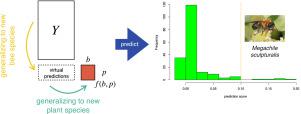Ecological Modelling ( IF 2.6 ) Pub Date : 2021-04-26 , DOI: 10.1016/j.ecolmodel.2021.109508 Michiel Stock , Niels Piot , Sarah Vanbesien , Joris Meys , Guy Smagghe , Bernard De Baets

|
Mutualistic bee–plant interaction networks are a vital part of terrestrial ecosystems. They frequently arise through co-evolutionary processes, which match the traits of both partners, facilitating their interaction. Insights in these interaction mechanisms are vital to be able to manage changing ecosystems. This entails the need for models to predict species interaction networks in general and pollination networks in particular.
We show how kernel-based pairwise learning can predict bee–plant interactions based on the traits and the phylogeny of the plant and bee species. The traits and the phylogeny of the plant and bee species proved to be highly predictive. Although the traits were slightly more informative compared to the phylogeny, the best results were obtained by combining both the traits and the phylogeny in the model Notably, the model performance varied greatly depending on whether the goal was to pinpoint missing interactions in the network or to predict interactions for new bee species, new plant species, or both. This issue highlights the importance of proper stratification when fitting biological network prediction models. Our model, however, showed the capacity to generalize beyond the original dataset provided by FlorAbeilles. The model was validated by predicting potentially interacting plant species for the invasive bee species Megachile sculpturalis. Four out of the five plant species identified by the model could be validated based on literature.
Our results indicate that pairwise learning has potential as a general method for supervised species interaction prediction. Caution should be taken to validate such models correctly.
中文翻译:

基于特征和系统发育的成对学习预测授粉相互作用
蜂-植物相互作用网络是陆地生态系统的重要组成部分。它们经常通过共同进化的过程出现,这些过程符合双方的特质,从而促进了他们之间的互动。这些相互作用机制的见解对于管理不断变化的生态系统至关重要。这就需要模型来预测一般的物种相互作用网络,尤其是传粉网络。
我们展示了基于核的成对学习如何基于植物和蜜蜂物种的性状和系统发育来预测蜜蜂与植物之间的相互作用。事实证明,该植物和蜜蜂的性状和系统发育具有高度的预测性。尽管与系统发育相比,这些特征具有更多的信息量,但通过将特征与系统发育相结合,可以获得最佳结果。值得注意的是,模型的性能差异很大,具体取决于目标是查明网络中缺少的相互作用还是确定网络中缺少的相互作用。预测新蜜蜂物种,新植物物种或两者的相互作用。这个问题凸显了在拟合生物网络预测模型时进行正确分层的重要性。但是,我们的模型显示了泛化能力超出了FlorAbeilles提供的原始数据集的能力。巨嘴。该模型确定的五种植物中有四种可以根据文献进行验证。
我们的结果表明,成对学习作为一种有监督的物种相互作用预测的通用方法具有潜力。应谨慎注意正确验证此类模型。











































 京公网安备 11010802027423号
京公网安备 11010802027423号